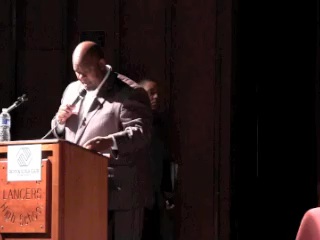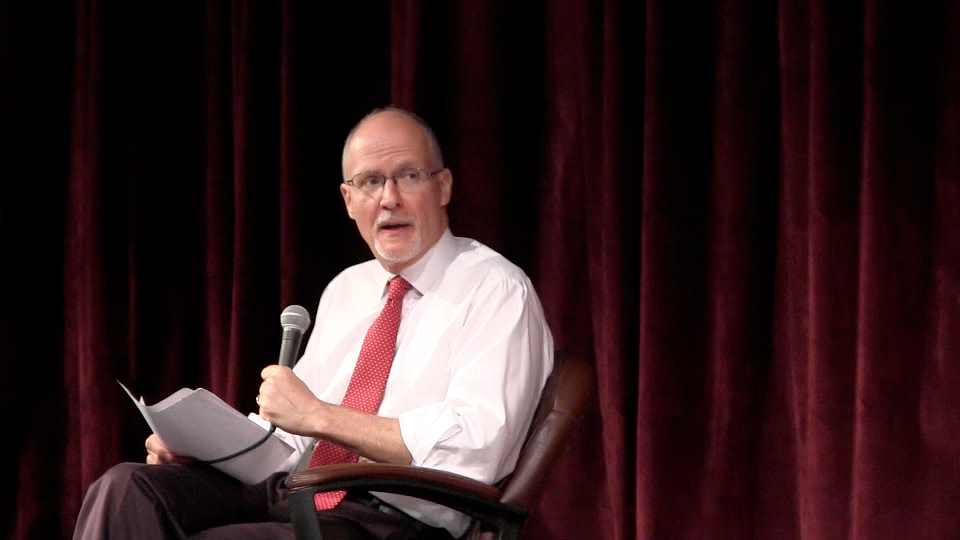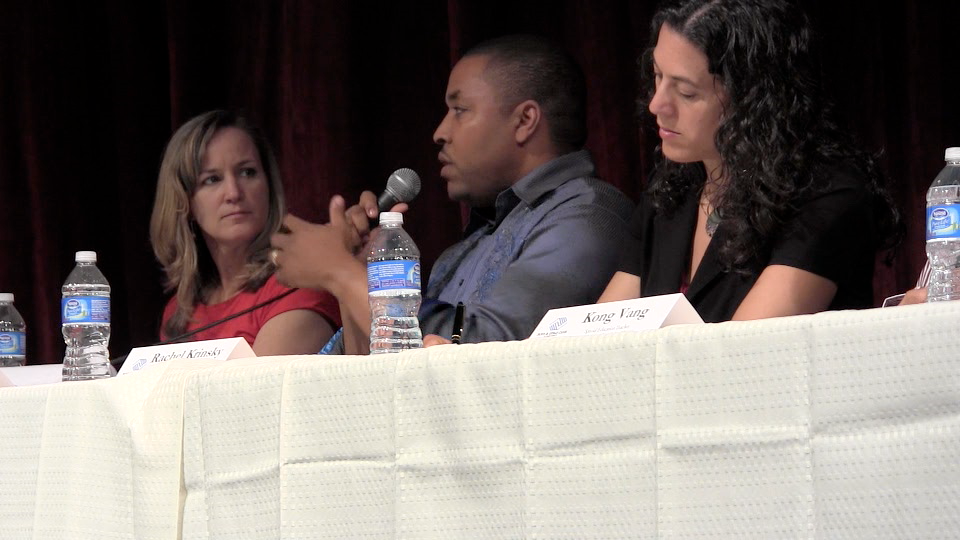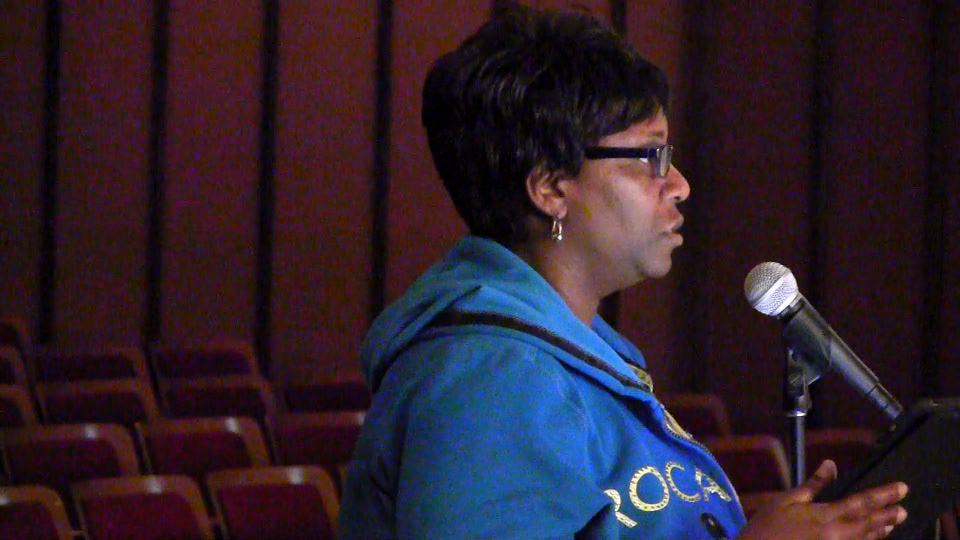Introductions by Michael Johnson
- Kimberly Boyd, National VP of Boys and Girls Club;
- Kaleem Caire, CEO of Urban League of Madison;
- Rachel Krinsky, CEO of YWCA;
- Kong Vang, local MMSD teacher;
- and Juan Lopez, former MMSD Board of Education member.

Click on picture to Play
Presentation by Paul Vallas
Praises Superintendent Nerad for being able to balance the budget as a key to making progress.
Vallas addresses statements of his positions and actions, indicating many are myths and are misinformed. He avers that it is a myth that he favored of privatization of public schools in Philadelphia. Philadephia had already pushed to privatize their schools to Edison Schools, Inc and he conditioned his tenure at Philadelphia on the halt of the privatization. All privatization schools in Philadelphia occurred prior to his tenure in Philadelphia. See Philadelphia Inquirer, Vallas, May 30, 2003.
Myth two is that he fired all the teachers in New Orleans; the old school board had fired all the teachers before he came. He had to open 22 schools, hire 1000 teachers, build 11 campuses, to house 22,000 kids, all in 90 days. He suggests contacting Larry Carter, President of Louisiana AFT to confirm his record in New Orleans.
His philosophy is school choices for parents. Supports charter schools and does not oppose vouchers. But does not advocate for vouchers, but matters of geography or income should not be determinative of the quality of the schools kids can go to. Public schools can do well and he works with public schools where neither vouchers nor charters are possible or desirable. His approaches work regardless.
Need to set expectations and get to the kids before the gap become too large.
Common features of high performing schools.
- Comprehensive preK-12 instructional curriculum and pedagogical model, research based and tools to support teachers.
- Use of data and assessments. Assessments are continuous, not high stakes, and are designed to determine when and how to remediate. RTI (Response To Intervention) both behavorial and academic and a set standard remedial steps.
- Training of teacher, job embedded training, with more effective teachers doing the training. All training is online, similar to Khan Academy. Training must be focused. Not abstract.
- Local school leadership teams. Too much responsibility and pressure on principals -- they cannot do it. Promote teachers and give them additional pay.
- Instructional time on task. Longer school day and longer school year is required. The additional time is needed. Children learn at different rates. In the current advanced countries, the US is far behind the others in the amount of time in school. For example, students in Singpaore using Singapore Math are instructed 90 minutes per day, 230 days a year. In contrast, in Massachusetts, Singapore Math is taught 48 minutes a day over a 180 day school year; that is not enough time to teach or learn the material.

Click on picture to Play
Panel Q&A with Paul Vallas
Kimberly Boyd: How does one extend the day to allow core curriculum to be taught? Many districts are limited in extending the school day and school year.
Vallas: In Bridgeport, all schools open another 2 1/2 hours per day, pushing enrichment, extracurricula, athletic and arts to end of day, increasing core curriculum to earlier in the day. To extend the day, we are using external community organizations and aligning these organizations to provide for enrichment, enhanced art and music, and sports. Teachers are not being required, they cannot be, to staff these times, but if they do, they get additional $37.50/hour. It is the alignment of community organizations to the school core that is having an important effect. At the high school level doing something similar, over the next three and four years, more staff will be allocated and focused on core subject areas, remediation, science and double-dose of math. Secondary tier electives will be handled in the extra hours by adding more clubs, more associations, more enrichment, more recreation for which kids can get partial elective credit, each supported by community organizations.
Kaleem Caire: Madison Prep was designed to offer the IB curriculum and partner with colleges such as Harvard, Stanford, Morehouse, a year or two of the elementary credits that will be given early college credit. Many in Madison scoffed at the idea that poor kids could make good use of the IB model. Discuss why and how early access to college level courses can be effective?
Vallas: It's more than IB partnering with colleges. It is very cost effective to give access to vocational, university and college. Bridgeport is partnering with these entities at a fair cost and sometimes free. It's something that the public schools don't have build, staff, and maintain. Vallas also discusses the expanded IB programs in 15 CPS high schools along with IB Prep, and references recent study. The idea is to create the opportunities without incurring costs and that can be sustained indefinitely.
- CBS Chicago: Vallas says U of Chicago Study Vindicates Rigorous IB Program
- Chicago Suntimes: Program designed for diplomats’ kids helps CPS kids’ chances in college
- Chicago IB Study, UChicago Consortium on Chicago School Research
Rachel Krinsky: Cites statistics that shows racial disparity in suspension rate of African American students was 29% in the 2009-10 school year compared to a rate of 4% for white students. What are the policies to reduce the racial disparity in school discipline and view of zero tolerance policies.
Vallas: Never ever expel a student to the street; need to create alternative placements based on behavior and student needs. In Philadelphia, the kids committing serious physical offenses tended to be two years older than classmates and two years behind academically so needed more than an alternative placement but also academic enhancements in transition classrooms targeted to elementary, middle and high school age students where they would be in age appropriate classroom settings. At same time, developed behavioral RTI that classroom teachers could rely on so that intervention was aligned to the offense.
Kong Vang: Data on the Asian-American group shows that they are experiencing academic success which exceeds the national average, though even then, there are other barriers they face. However, this aggregation of different Asian ethnic groups under the Asian-American rubric obscures the reality that many subgroups of Asian-Americans are not experiencing academic success. How can we encourage disaggregation of the Asian-American groups by districts to accurately reflect the disparity of academic and economic success?
Vallas: It's really poverty not ethnicity. The approach should always look at highly disaggregated data, and further, meeting regularly with each different ethnic community and their representatives so the district could get feedback, such as for those just arriving in the district. The longer school day is also key to addressing the issues and giving support not only to students but to parents; the longer school day allows the tailoring interventions to the needs of each community.
Juan Lopez: Achievement gap data supports the idea that it's poverty and not race from the perspective of the majority of the typical white middle-class, but the race issue has a lot to do with training and staffing, and feeds into the distrust by parents and communities of color of the districts across the country, including Madison. What has been your experience and perspective on this issue?
Vallas: Achievement gap must be narrowed by longer days and differentiated instruction and immersion. The additional time is needed, both by extending the day and the school year, to do the prescribed interventions.
The reluctance and distrust of communities should be solved by ensuring that the community has a presence in the schools. Every school must have parent and community councils, and all schools have parent support centers, which are bilingual if that is necessary. So, when parents come to the schools, they see themselves there, who can guide them, coordinate with social services for example. Diversity in hiring can only be accomplished by going to where the diversity is and hiring the best, the upper 5%, not passively announcing job openings and hiring from those who happen to apply.

Click on picture to Play
Audience Q&A with Paul Vallas, Part 1
- What is your opinion about the effectiveness of teaching Home Talk and School Talk differences within Head Start and other such initiatives?
- What is your opinion on curriculum that does not reflect the students history and background and how to bring those topics into the curriculum?
- Southern Poverty Law Center has sued the NOLA school district for not supporting special needs students. What is your view of the suit?
-
There are many black families in Madison that are middle class, educated, value education, are involved with early literarcy, and still their children are on the wrong side of the achievement gap. Why is that the case?
Black families consider teachers role models, yet in the Madison district, kids can go K through 12 and never see a teacher that looks like them. How do you solve that?
What can you do when the black community has been pushing for all the strategies that you have recommended to improve the schools and the Board has ignored your requests?
- What is the timeframe needed to implement the strategies you have advocated?

Click on picture to Play
Audience and Panel Q&A with Paul Vallas, Part 2
- Kimberly Boyd: How do we evolve from high stakes testing such as mandated by NCLB to more the frequent assessment model used to guide individual student learning?
- Our community is very divided over how to bridge the gap, and each segment opposes or supports charters, instrumentality, non-instrumentality, private, public schools, teacher unions, etc. What are the strategies to bring each segment together instead of arguing political ideologies to achieve the common goal of student success?
- Can you draw on one community that has succeeded in pulling together the stakeholders to improve schools.
- Non-traditional parents need support from services to allow their students to succeed in getting an education. Coordination among service providers is lacking. How do we go about coordinating service providers to ensure student success?
- Who is driving the school reform movement? I think the charter school movement is pushed by those who will make a profit from the movement, rather than charters being pushed by parents. It also seems that the military are mostly embedded in poor minority schools rather than in affluent schools. Are the JROTC schools in the poor neighborhoods for the good of the students or are they in the schools to provide the bodies for the military?
- Derrell Connor: Poverty does play a role in school success. But, we seem to go further and say that students in poverty cannot learn and that we need to eliminate poverty before student success can be achieved. Poverty is never going away. How much does poverty play a role, or does it have to do more with people and adults caring about their success?
- Kong Vang: Teachers are under attack. What are your approaches to working with teachers, increasing teachers' morale, improve teacher professional development, and ensuring students get the education they need.

Click on picture to Play